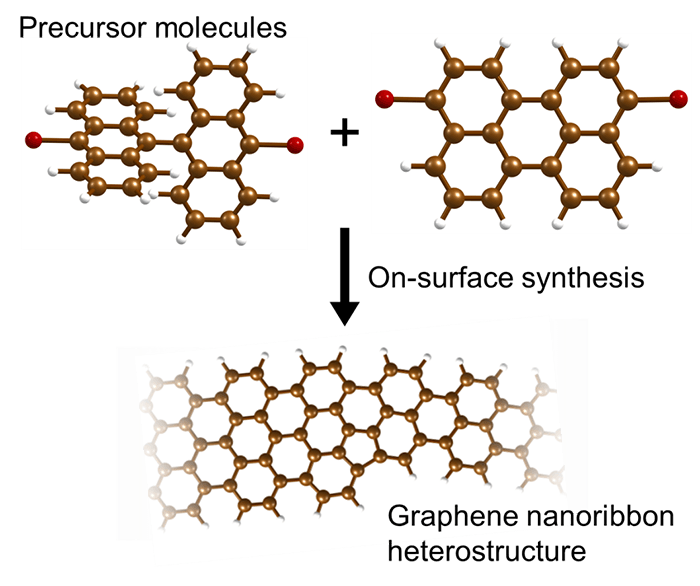Jul 26 2017
Important electronic components, such as tunnel barriers and diodes, can be integrated into single graphene wires (nanoribbons) with atomic precision. The aim is to make graphene-based electronic devices with very fast operational speeds.
Aalto University Researchers made the discovery in collaboration with their colleagues at TU Delft and Utrecht University in the Netherlands. Their research was published in Nature Communications.
 Schematic of the synthesis procedure for the graphene nanoribbon heterostructures: Precursor molecules are converted through chemical synthesis into precisely controlled graphene nanoribbons. Image: Aalto University, Utrecht University and TU Delft.
Schematic of the synthesis procedure for the graphene nanoribbon heterostructures: Precursor molecules are converted through chemical synthesis into precisely controlled graphene nanoribbons. Image: Aalto University, Utrecht University and TU Delft.
The ‘wonder material’ graphene has several interesting characteristics and Investigators around the world are searching for new ways to utilize them. By itself, graphene does not have the characteristics required to switch electrical currents on and off and therefore, smart solutions have to be identified for this particular problem.
We can make graphene structures with atomic precision. By selecting certain precursor substances (molecules), we can code the structure of the electrical circuit with extreme accuracy.
Peter Liljeroth, Aalto University, who conceived the Research Project in cooperation with Utrecht University
Seamless integration
Graphene’s electronic properties can be controlled by making it into very narrow strips (graphene nanoribbons). As shown in earlier research, the electronic characteristics of the ribbon are dependent on its atomic width. A ribbon that is five atoms wide works similar to a metallic wire with very good conduction characteristics, but adding two atoms can make the ribbon a semiconductor.
We are now able to seamlessly integrate five atom-wide ribbons with seven atom-wide ribbons. That gives you a metal-semiconductor junction, which is a basic building block of electronic components.
Ingmar Swart, Utrecht University
Chemistry on a surface
Through a chemical reaction, the Researchers generated their electronic graphene structures. They evaporated the precursor molecules on a gold crystal, where they react in an extremely controlled way to produce new chemical compounds.
This is a different method from that currently used to produce electrical nanostructures, such as those on computer chips. For graphene, it is so important that the structure is precise at the atomic level and it is likely that the chemical route is the only effective method.
Ingmar Swart, Utrecht University
Electronic characteristics
The Researchers also employed advanced microscopic techniques to determine the transport and electronic characteristics of the resulting structures. Through a graphene nanoribbon device with a precisely known atomic structure, it was possible to measure electrical current.
“This is the first time where we can create e.g. a tunnel barrier and really know its exact atomic structure. Simultaneous measurement of electrical current through the device allows us to compare theory and experiment on a very quantitative level,” says Peter Liljeroth.
This research was funded by the Academy of Finland, the European Research Council and NWO (The Netherlands Organisation for Scientific Research) Graduate Programme.